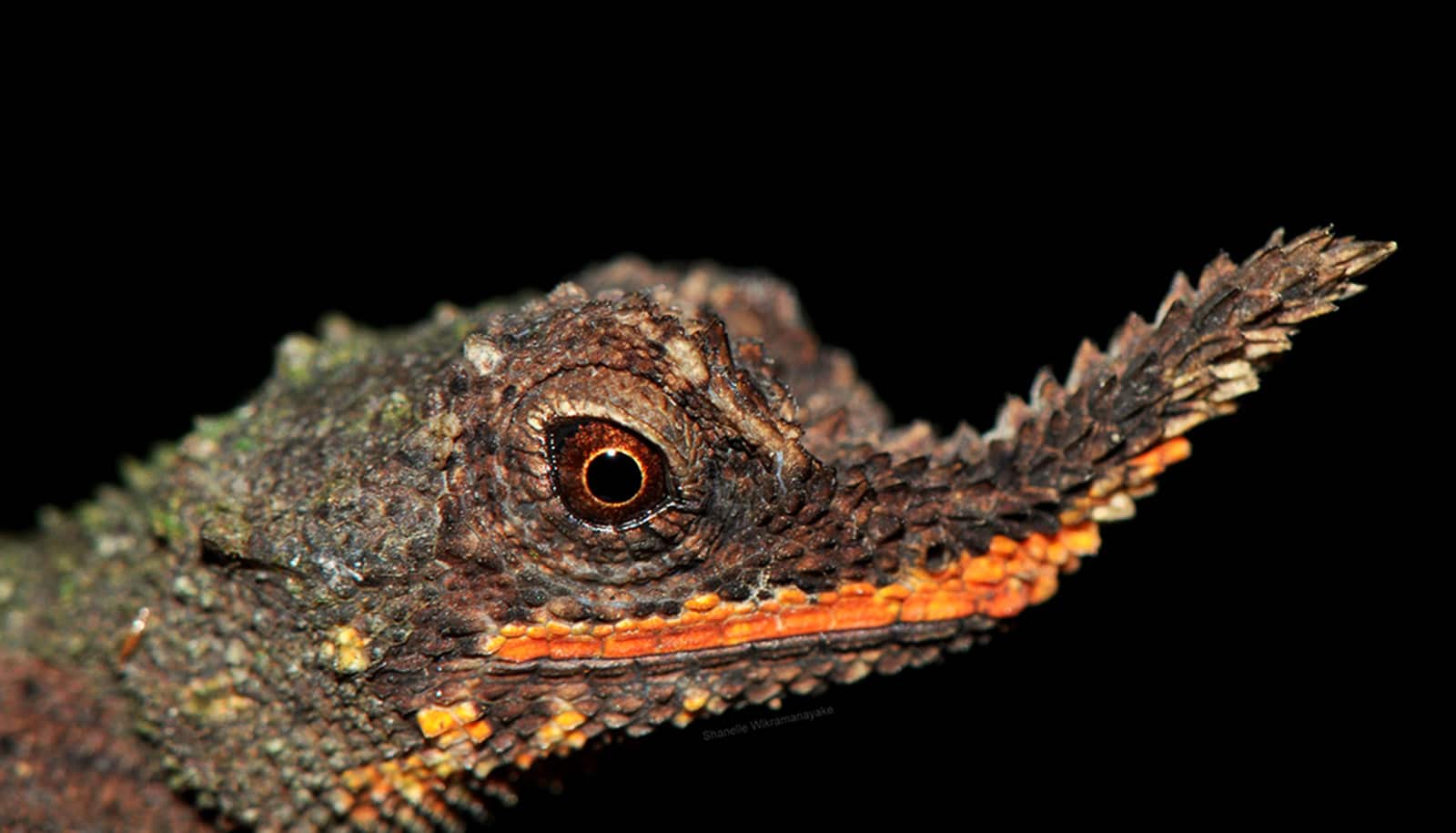
Above, a rough-nosed horned lizard ( Ceratophora aspera ). (Credit: Shanelle Wikramanayake via Burke Museum/U. Washington)
Tail snips offer clues to saving tiny lizards in Sri Lanka
New research suggests how to conserve rough-nosed horned lizards, which live only in Sri Lankan rainforests.
New research suggests how to conserve rough-nosed horned lizards, which live only in Sri Lankan rainforests.
Characterized by the prominent horn in males, rough-nosed horned lizards ( Ceratophora aspera ) live in moist, humid microhabitats in rainforests and palm groves. These lizards are a good example of the consequences of rainforest habitat destruction, climate change, and the pet trade, as they are found throughout the lowland rainforests of Southwestern Sri Lanka.
By analyzing the certain types of mutations in the genome of these lizards , the team was able to determine how geography and historical events affect the distribution of the remaining wild populations of rough-nosed horned lizards. Recent University of Washington graduate Shanelle Wikramanayake led the study as part of her undergraduate work, and is now completing her master’s degree at California State University, Northridge.
The team got DNA from the rough-nosed horned lizards by a catch-and-release approach of capturing wild lizards and taking tissue samples from the tips of their tails before releasing them back to the wild, which minimizes stress to the animals. They took samples across eight forests representing four forest groups from July through September 2018 and 2019, respectively.
In addition to habitat destruction, nonnative species like cats and chickens eat these lizards, causing further harm to them and other prey animals. The team recommends a conservation strategy that considers the population structure, history, and ecology of rough-nosed horned lizards to preserve genetic diversity.
The results from the DNA analysis found rough-nosed horned lizards are separated by distance into four forest groups: Southern Lowlands, Sabaragamuwa Hills, Central Highlands, and Kithulgala. With the Sri Lankan government pledging to restore rainforest habitats, the results from the study can help inform guidelines for forest landscape restoration.
For example, the similarities in populations and close geographic proximity between the lizards living in the Hiyare and Kottawa forest reserves in the Southern Lowlands forest group is a great candidate for habitat restoration. The two populations could reconnect, increasing the chances for interbreeding, which could result in a stronger gene pool for future generations and less vulnerability to extinction.
“I hope this study brings attention to the unique and obscure biodiversity in the rainforests of Sri Lanka that require urgent conservation action,” says Wikramanayake. “It’s important to consider the genetic diversity in populations across their range when looking at conservation planning and strategies. This principle should also be considered in other forest ecosystems, where conservationists are planning restoration and habitat connectivity at landscape scales.”
In addition to these lizards, the researchers are currently considering extending this work to other animals and other regions of Sri Lanka of high conservation value. In Sri Lanka, approximately 14% of mammals, 6.5% of birds, 75% of reptiles, and 29% of flowering plant species aren’t found anywhere else in the world. The methods of DNA analysis in this study not only inform conservation planning in Sri Lanka, but also can apply to species living in other at-risk rainforests, including Madagascar, Borneo, and the Amazon.
The findings appear in the journal Biotropica . Coauthors are from the University of Washington, the UW Burke Museum of Natural History and Culture, WWF Hong Kong, and the University of Colombo.
The remaining tissue samples will join photos of the lizards at the department of zoology and environment sciences at the University of Colombo. In addition, the DNA analysis from the team’s work is available online, where the samples and analysis are available to other researchers.
Source: University of Washington
The post Tail snips offer clues to saving tiny lizards in Sri Lanka appeared first on Futurity .
Share this article:
This article uses material from the Futurity article, and is licenced under a CC BY-SA 4.0 International License. Images, videos and audio are available under their respective licenses.
Related Articles:
Cats don’t roam far, but they do lots of killing
March 12, 2020 • futuritySniffing out lizard poop could offer a way to save them
Nov. 5, 2019 • futurityLinks/images:
- https://www.futurity.org/smaug-dragon-lizard-species-2317282-2/
- https://www.futurity.org/house-cats-hunting-wildlife-2304292/
- https://doi.org/10.1111/btp.12970
- https://www.burkemuseum.org/news/new-dna-study-provides-critical-information-conserving-rainforest-lizards
- https://www.futurity.org/rough-nosed-horned-lizards-sri-lanka-2606572-2/
- https://www.futurity.org


